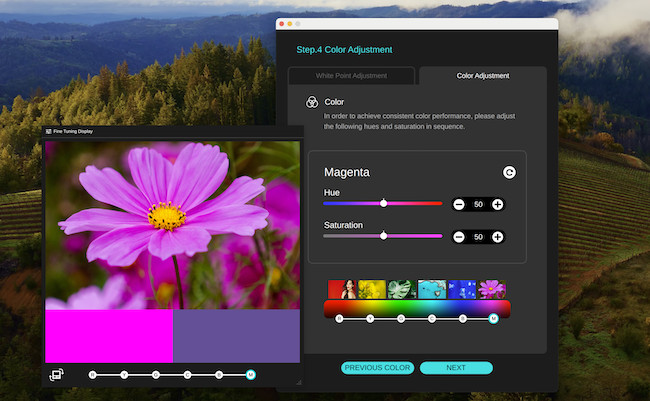For a few years now, BenQ has been trying to release a genuine alternative to the Apple Studio Display and with the fantastic new 5K PD2730S we think they’ve finally done it.
We were massively impressed with BenQ’s previous efforts; firstly the graphic design oriented 32 inch PD3225U Design Monitor and then later the excellent value 27 inch MA270U.
Both went the extra mile compared to most displays with out-of-the box macOS calibration.
But there was one big problem with both of them when comparing them against the Apple Studio Display – they’re both only 4K.
The PD2730S finally offers the same 5K resolution as the Apple Studio Display and crucially, 218 pixels per inch meaning it scales perfectly with MacBook Liquid Retina Displays.
BenQ offered us the chance to try this stunning monitor and it immediately impressed us as one of the best 5K monitors for Macs we’ve ever tried and a serious alternative to Apple’s 5K Studio Display.
Unless you’re lucky enough to get the Apple Studio Display discounted refurbished, I think the PD3225U offers superb value compared to Apple’s product.
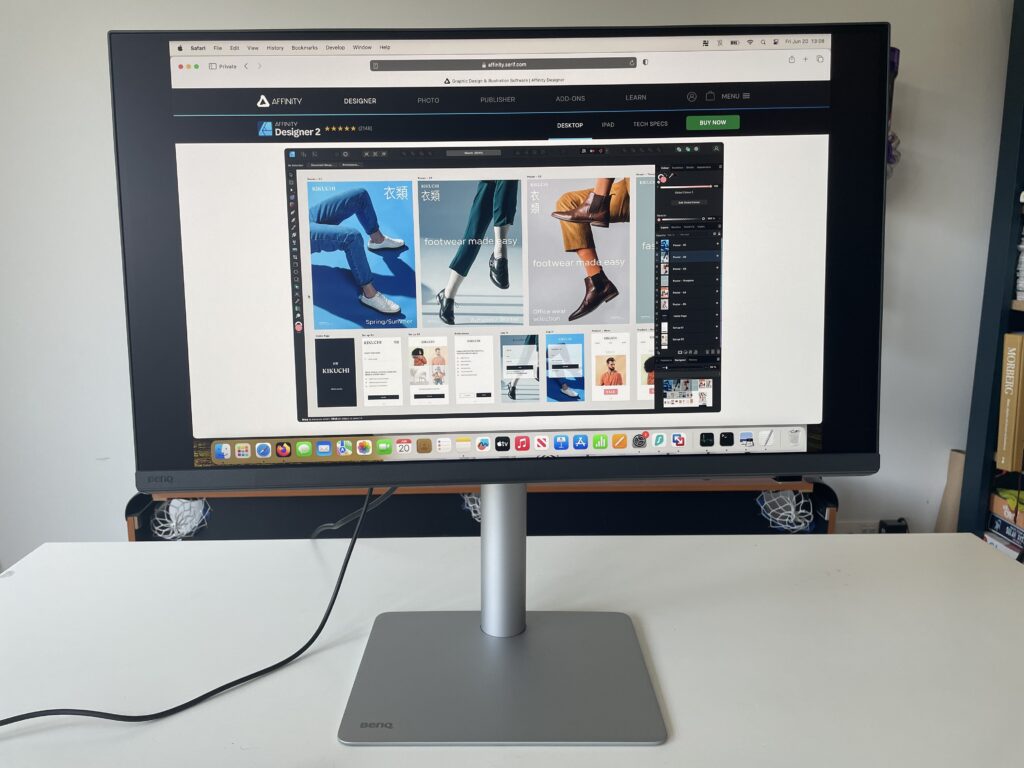
Table of Contents
- PD2730US Overview & Specs
- Why Does The PD2730S Compare So Well With The Apple Studio Display?
- What’s In The Box?
- PD2730S Design
- Setup
- Connecting The Display
- Display Quality
- Display Pilot 2 & M-Book Mode
- Palette Master Ultimate & Display ColorTalk
- Performance
- Glare Reduction
- Adjustable Stand
- Speakers & Headphones
- Wireless Hotkey Puck
- Who’s It Aimed At?
- PD2730S vs PD3225U vs MA270U
- PD2730S vs Apple Studio Display
- PD2730S Pricing & Availability
PD2730US Overview & Specs
The PD2730SU is part of BenQ’s PD range, which is aimed specifically at content creators such as graphic designers, video editors, CAD/CAM users, and 3D modeling professionals.
The key specifications are as follows:
| Feature | Spec |
|---|---|
| Display Size | 27 inches |
| Resolution | 5120 x 2880 (5K) |
| Panel Type | IPS |
| Gamut Coverage | 98% DCI-P3, 100% sRGB, 100% Rec.709 |
| Color Accuracy | Delta E ≤ 2 |
| HDR Support | HDR400 |
| Thunderbolt 4 | ✔️ (2x ports, 90W PD passthrough) |
| DisplayPort | ✔️ (1.4) |
| HDMI | ✔️ (2.0) |
| USB-C | ✔️ (1x with 90W PD) |
| USB Hub | ✔️ (3x USB-A, 1x USB-C) |
| Webcam | ❌ |
| Speakers | ❌ |
| Adjustable Stand | ✔️ Height, Tilt, Swivel, Pivot |
| Built-in Calibration Report | ✔️ (ΔE < 3) |
Why Does The PD2730S Compare So Well With The Apple Studio Display?
In the world of monitors and displays, and when it comes to Macs, it’s all about the resolution and pixel density support.
Monitors can claim to be as “Mac compatible” as they want but unless they support 5K and a pixel density of around 218 pixels per inch, they’re not going to scale well with macOS.
5K resolution and a pixel density of around 218 PPI are important when connecting a monitor to a Mac because they closely match the Retina display standards Apple uses in its own hardware.
macOS is designed to scale best at a “2x” Retina factor, meaning it renders everything at twice the pixel resolution and then downscales it for sharp, crisp visuals.
On a 5K 27-inch monitor with 218 PPI, macOS can render the interface at 5120×2880 and scale it perfectly to look like 2560×1440, maintaining sharp text and UI elements without distortion or blur.
Lower-resolution monitors, including BenQ’s 4K models, or those with non-Retina pixel densities often result in scaling compromises, leading to soft or uneven image quality.
The result is you end up having to mess around with third party apps like BetterDisplay to try and improve the scaling issues.
So right from the start, the fact that the PD2730S supports both 5K and 218 PPI mean BenQ can claim this is genuinely more Mac compatible than its previous monitors and a worthy rival to the Studio Display.
For a more in-depth look at the the two monitors, check out our head-to-head PD2730S vs Apple Studio Display for more.
What’s In The Box?
Inside the PD2730S box you get the Monitor, the stand (in two parts), power cable, Thunderbolt 4 cable, HDMI cable, USB-C cable, Hotkey Puck, cable ties organizer and factory color calibration report.

PD2730S Design
The first thing I noticed about the BenQ PD2730S is how sleek and understated it looks. I’ve reviewed several BenQ monitors over the years and they always impress with the design aesthetic.
The Nano Matte black finish looks slick and also helps to reduce glare or reflections behind you (more on this later).
The bezels are slim but not razor-thin, striking a good balance between screen estate and looks.
Like most BenQ’s we’ve tried, the steel-necked stand feels solid and well-built, with a smooth vertical adjustment and easy tilt and swivel options that make positioning really easy.
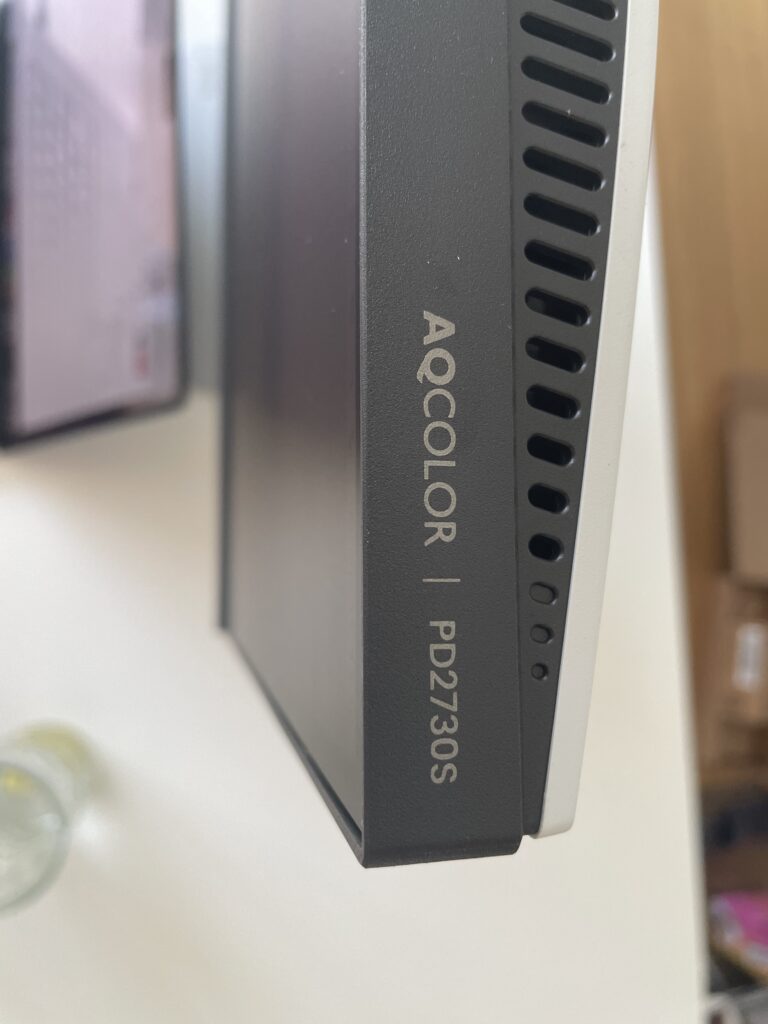
The rear panel has a tasteful cream color finish but a bit plasticy like other BenQ’s I’ve tested although this is not exactly something you’ll see every day anyway.
Like all BenQ monitors, putting it all together is very simple by simply clipping the neck of the stand to the back.
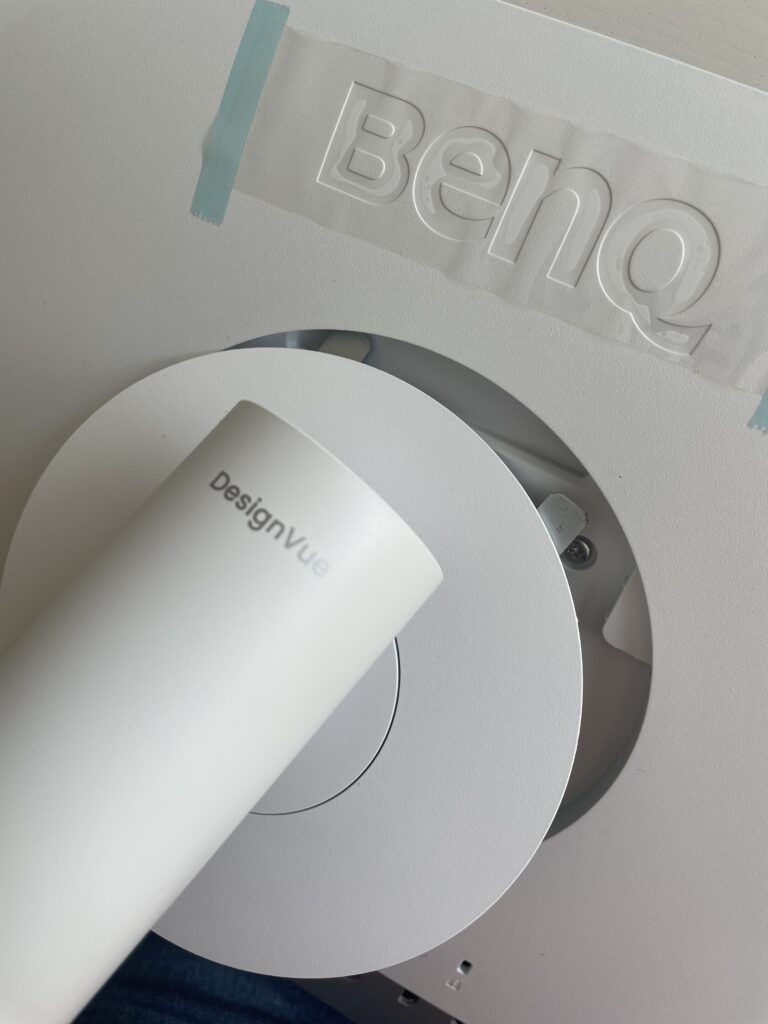
You then screw on the base with the provided key-screw, no tools required.
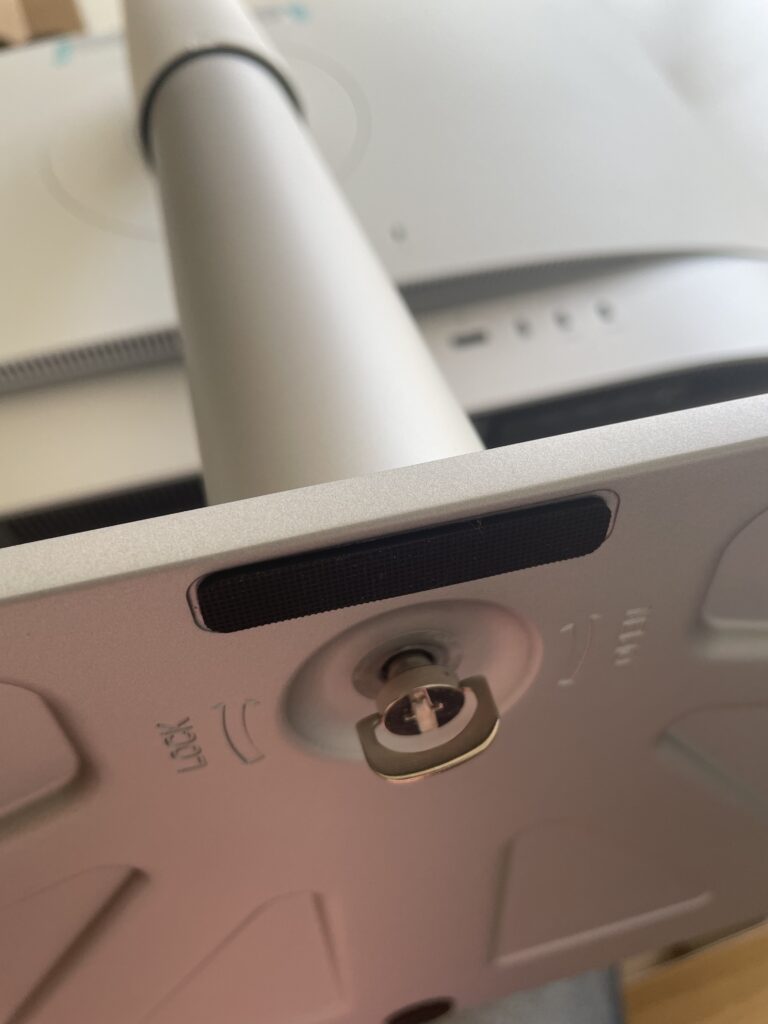
The steel neck of the stand is really solid and monitor moves smoothly up and down it if you want to adjust the height.
You can use a VESA mount if you prefer (maximum size 100 x 100mm) but we found the stand is more than stable enough.
Setup
The power supply is inside the BenQ PD2730S so there’s no big power brick to worry about.
On the back of the monitor you’ve got a huge choice of connection ports and in this respect, it blows the Apple Studio Display out of the water.

The big highlight is the inclusion of the Thunderbolt 4 ports which aren’t available on BenQ’s 4K MA270U.
Thunderbolt connections support data transfer speeds of up to 40 Gbps which is 4 times faster than USB 3.2 Gen 2 ports and all Macs have Thunderbolt ports.
The exact port connections available are:
- 1× Thunderbolt 4 upstream (40 Gbps, DisplayPort Alt‑Mode, 90 W Power Delivery for laptop charging)
- 1× Thunderbolt 4 downstream (for daisy‑chaining another 5K display or using as USB hub, 15 W PD)
- 1× HDMI 2.1 input
- 1× DisplayPort 1.4 input
- 1× USB‑C upstream (USB 3.2 Gen 2, data only, 10 Gbps)
- 1× USB‑C downstream (USB 3.2 Gen 2, 10 Gbps, 7.5 W power output)
- 3× USB‑A downstream (USB 3.2 Gen 2; one port delivers 10 Gbps, two ports deliver 5 Gbps; power charging)
- 1× 3.5 mm headphone jack
Some of these are on the bottom edge for easy access, handy for connecting headsets or external SSD drives without reaching behind the screen.
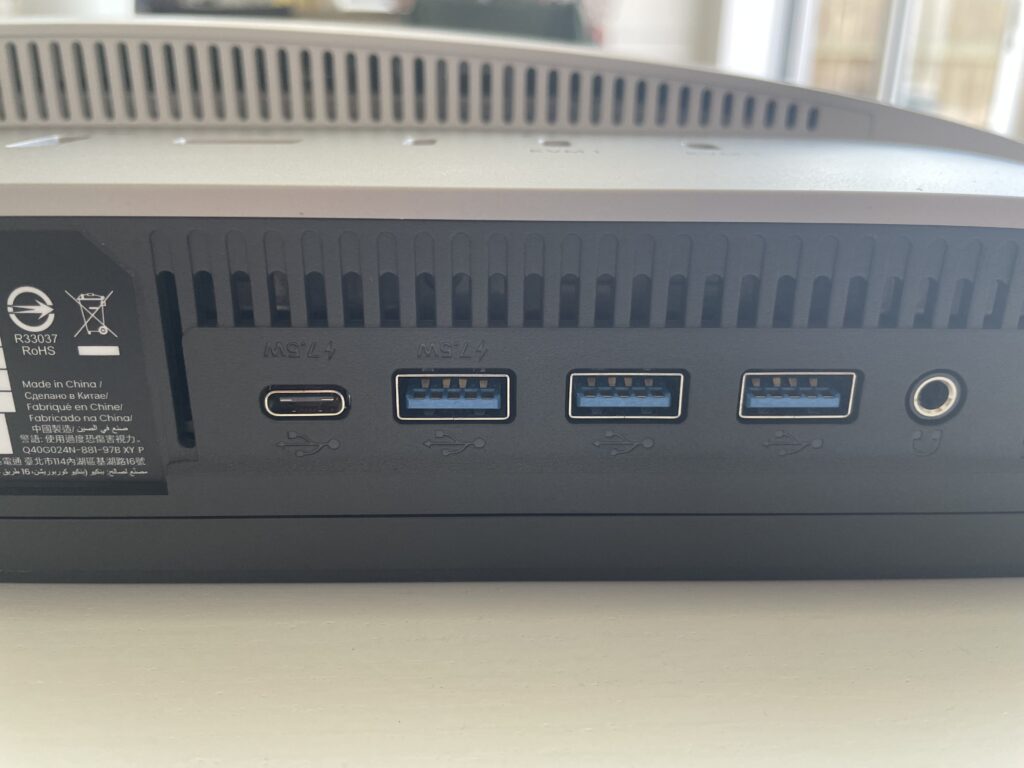
This makes it easily one of the most well connected BenQ monitors we’ve tried and offers various benefits including:
- Single‑cable docking: Connect your Mac via Thunderbolt 4 and enjoy 5K display, 90 W charging, and USB device support—all through one cable.
- Daisy‑chain ready: Hook up a second 5K display using the downstream TB4 port for expanded screen real estate.
- Versatile device hookups: HDMI and DisplayPort inputs ensure compatibility with a variety of devices.
- Convenient USB hub: Plenty of downstream ports let you connect peripherals directly to the monitor.
On the right of the display underside, you also have the power button and OSD (On Screen Display) controls although we’d advise using the Display Pilot 2 software for managing the monitor as we’ll get onto shortly.
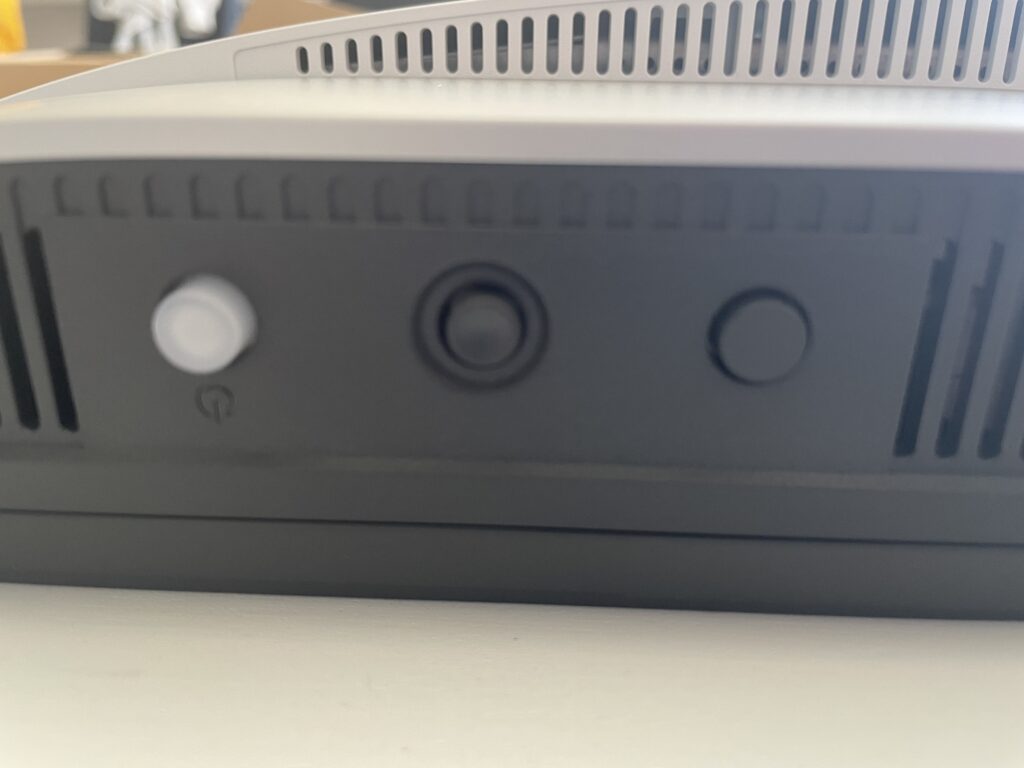
Connecting The Display
When you connect the BenQ PD2730S for the first time, your Mac should recognize it. Unlike the last BenQ that I tested which was only recognized as a “Generic USB2.1 Hub”, BenQ has clearly fixed this little glitch and the monitor correctly identifies itself immediately to macOS as the PD2730S.

When you click “Allow”, your Mac desktop should appear immediately on the BenQ MA series monitor.
If you go the Apple logo in the top left of your screen and select System Settings > Displays you will see the monitor has been recognized and connected.
Graphic Designers can also choose a specific Color Profile to use here too although you can also do this with the Display Pilot 2 software.
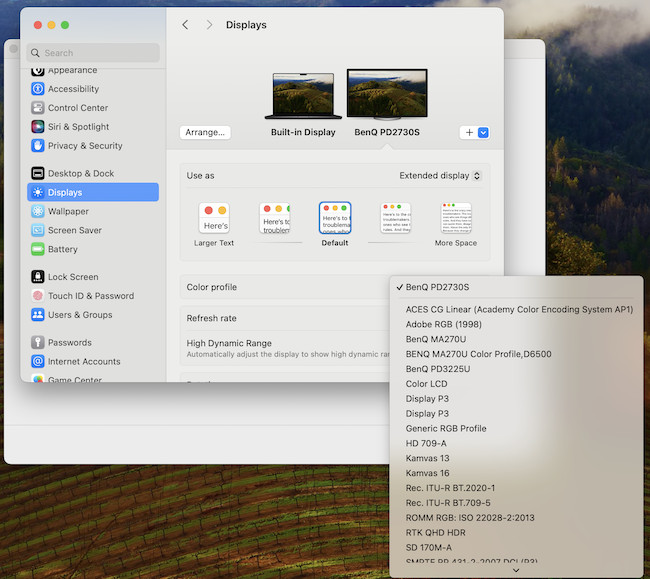
Display Quality
The 5K resolution (5120 x 2880) is the same as Apple’s Studio Display and perfectly matches macOS Retina scaling at 2x. Text and UI elements are sharp with no scaling artifacts.
The clarity and sharpness of text and images is absolutely stunning. I zoomed in with an iPhone on the Dock and you’d normally expect to see some pixelation but the text and Dock icons remains crisp even close up.

As with previous BenQ models we’ve tested, the PD2730S comes with a factory calibration report in the box, showing Delta E values under 3 for both DCI-P3 and sRGB modes which are important for color-critical work.
Some of the stand out color features of the PD2730S display are:
- The IPS panel offers wide viewing angles and consistent colors
- Factory calibrated with ΔE < 3 (report included in the box)
- Covers 99% of DCI-P3, 99% sRGB, and 99% Rec.709
- Supports HDR400, though this is more for previewing than true HDR mastering
- Color depth is 10-bit (8-bit + FRC) for smoother gradients
- Color accuracy is Delta E ≤ 2
I’m not a graphic designer or video editor but even to my untrained eye, I could tell that the color reproduction was incredibly similar to the MacBooks display when mirroring it.
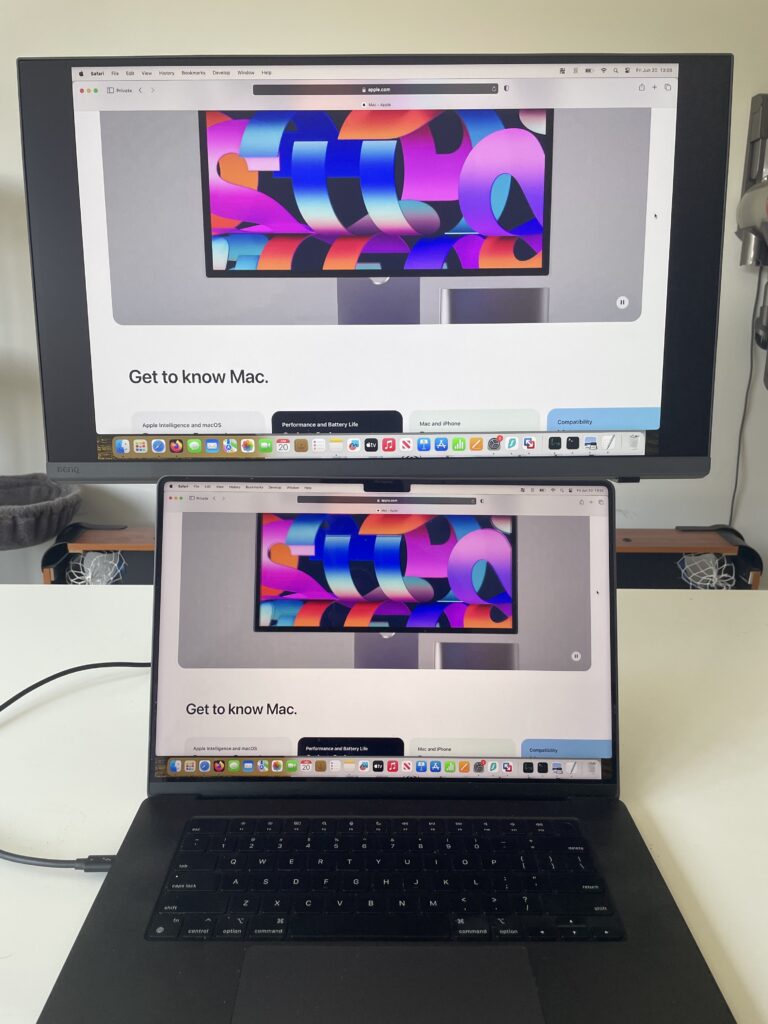
Display Pilot 2 & M-Book Mode
One of best things about using any BenQ monitor on a Mac is the Display Pilot 2 software.
Once installed, Display Pilot 2 allows brightness/volume adjustment via your Mac keyboard using iKeyboard Control, synchronizes ICC color profiles (via ICCsync), switches display modes, and offers handy tools like desktop partitioning and M‑book mode.
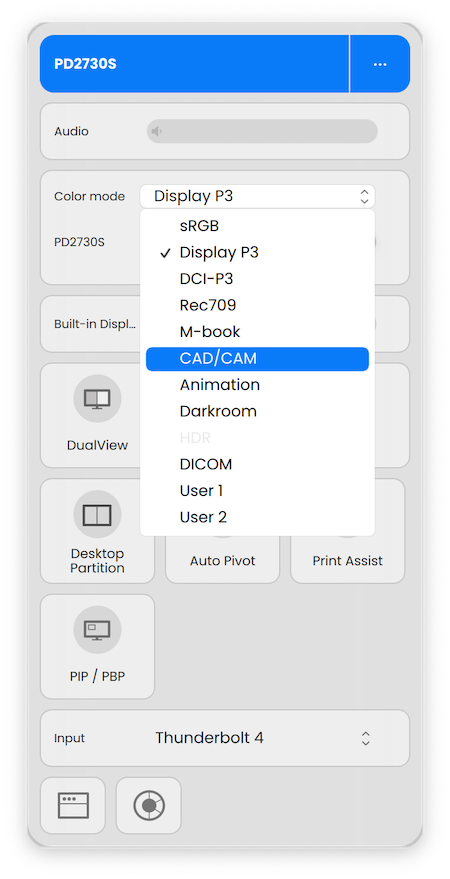
BenQ’s M-book Mode is a display preset designed specifically to match the color output of your MacBook’s built-in Retina display.
When enabled in the Display Pilot 2 software, it adjusts the monitor’s color temperature, gamma, and white point to closely align with Apple’s default display calibration.
The main advantages of this are:
- Color consistency: It helps ensure what you see on your external monitor looks nearly identical to your MacBook screen, especially important for creatives working across both displays.
- Plug-and-play convenience: No need to manually tweak color settings or calibrate the monitor when switching between internal and external displays.
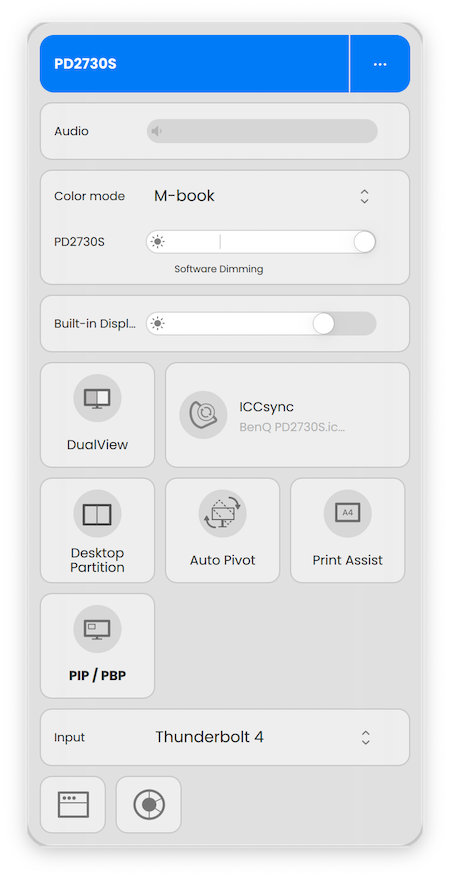
As we found in previous tests, the color matching was incredibly accurate with our M3 MacBook Pro’s Liquid Retina XDR display.
Many monitors suffer from backlight bleed (where light from a monitor’s backlight leaks around the edges) and struggle to match the exact colors of your MacBook’s display, but this definitely wasn’t the case with the BenQ PD2730S.
Apart from M-Book mode switching, the Display Pilot 2 software is far more customizable than using the On Screen Display (OSD) to configure the monitor.
It sits in the Menu Bar at the top of your screen and if you click on the three dots in the top right corner and select the Advanced tab across the top, you’ll also get access to many of the Display System Settings.
Here there are options such as Always-On Power Charging to make sure the monitor continues charging your MacBook even when it is off and Backlight Control.
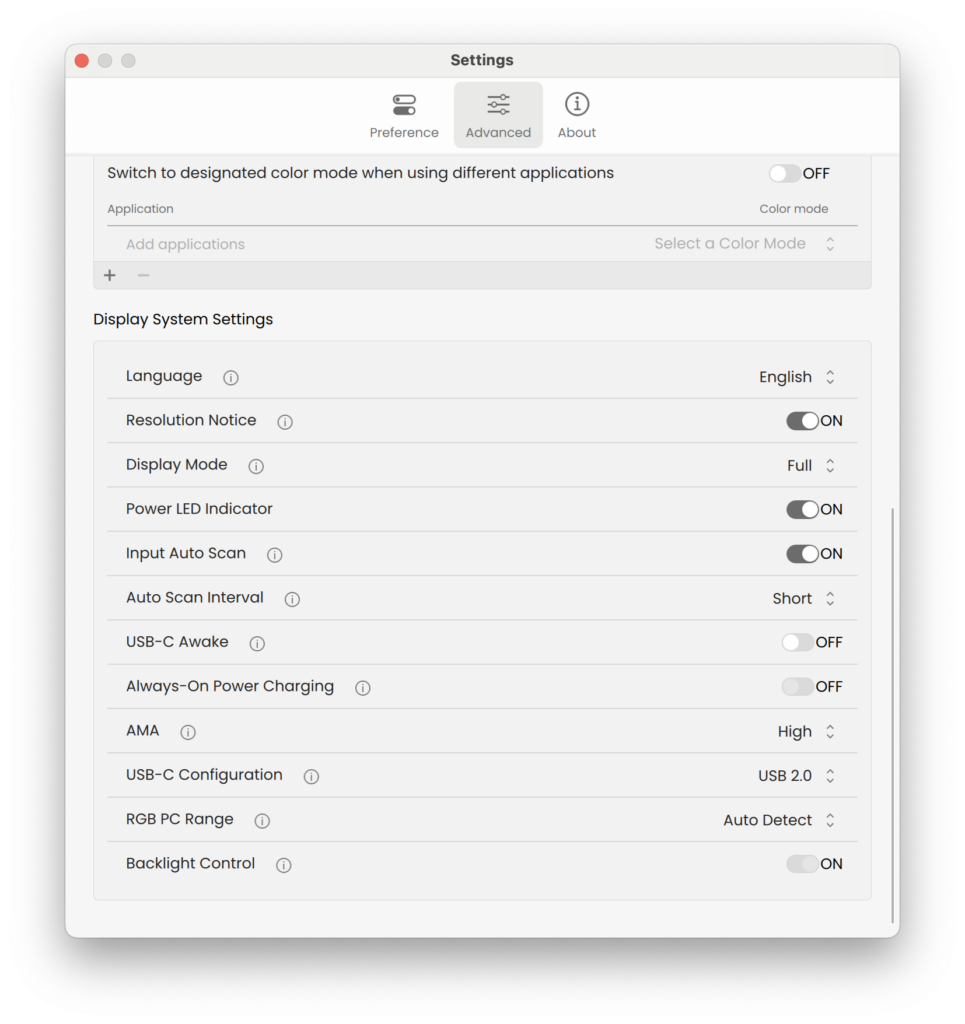
BenQ’s ‘Workspaces’ tool in Display Pilot 2 allows you to save and switch between custom app layouts.
While the latest versions of macOS now offer native window tiling, BenQ’s system is still useful for saving pre-defined multi-app arrangements across inputs if you switch monitors regularly.
Despite all these helpful touches, the Display Pilot 2 software is a bit overwhelming and only experienced graphic designers will likely need (or understand) half of the options on there.
However, it’s much better than the usual manually operated On Screen Display (OSD) you get with most monitors.
One thing to note is that Siri functionality (e.g., voice shortcuts, toggling display settings via voice commands) is not included in the PD2730S as it is exclusive to BenQ’s MA-series monitors.
To be honest, I almost never use this anyway and it’s no big loss but if you’re looking for Siri integration, you won’t find it in this monitor.
Palette Master Ultimate & Display ColorTalk
BenQ offers the PD2730S two additional powerful color tools designed for creative professionals: Pallet Master Ultimate and Display ColorTalk.
They’re mainly designed for those that use graphic design software and photo editing software but they’re both far and above anything else I’ve seen on any other non-Apple monitor when it comes to calibration.
Note that BenQ has advised on this reddit thread to not use both tools at the same time as it may cause color conflicts so to be on the safe side, I’d only recommend using them separately.
Palette Master Ultimate (PMU)

PMU is a significant step up from BenQ’s older Palette Master Elements, with easy to use calibration and hardware-level control. The main features are:
- Built‑in hardware calibration: This writes directly to the display’s internal 3D LUT (Look-Up Table) which allows more precise color and gamma adjustments via compatible calibrators like X‑Rite i1 Display Pro/Plus and Datacolor Spyder X/X2.
- Basic & Advanced Modes: Fortunately for me PMU offers both basic and advanced modes, with visual guides and real‑time previews to make it relatively easy for beginners to calibrate the monitor. The idea is that it saves you time calibrating the monitor manually.
- Cross‑monitor matching: It also includes a “Measure and Match” feature to ensure uniform color across multiple displays which is useful for those that use multiple 5K monitors.
I didn’t have a device to calibrate or the expertise to fully get the most out of it but searching around most users report that PMU delivers consistent Delta E ≤ 2 results.
However, it does seem that it requires Rosetta to work on Macs (meaning it’s not designed to work natively on Apple Silicon models) which can result in instability and crashes.
Display ColorTalk
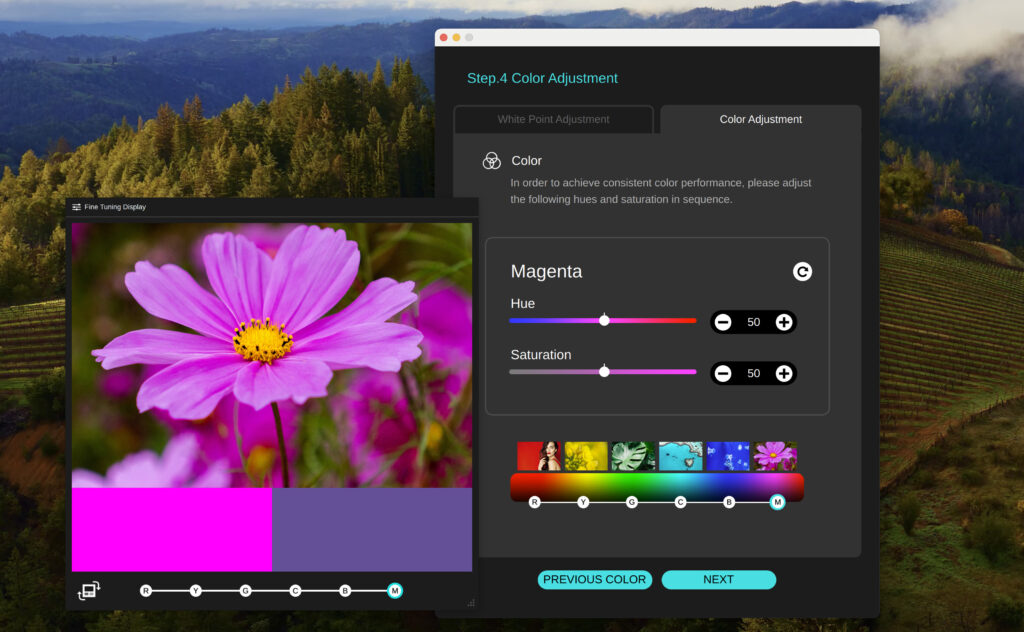
Display ColorTalk is basically a simple calibration software to provide alignment between displays, even if you don’t have a colorimeter.
- Color matching without a calibration device: The software is aimed at users without a calibrator and relies on internal display presets and DDC/CI control to match two BenQ PD or SW series monitors (such as the BenQ PD3220U or BenQ MA270U).
- Very quick setup: Display ColorTalk is ideal for creative teams or agencies that need consistent color across screens without investing in hardware.
I found ColorTalk extremely easy to use, even without much color calibration experience.
Ultimately, both ColorTalk and Palette Master Ultimate are designed to enhance BenQ’s AQCOLOR‑certified color accuracy and again, are another example of where the PD2730S goes the extra mile for color professionals.
Performance
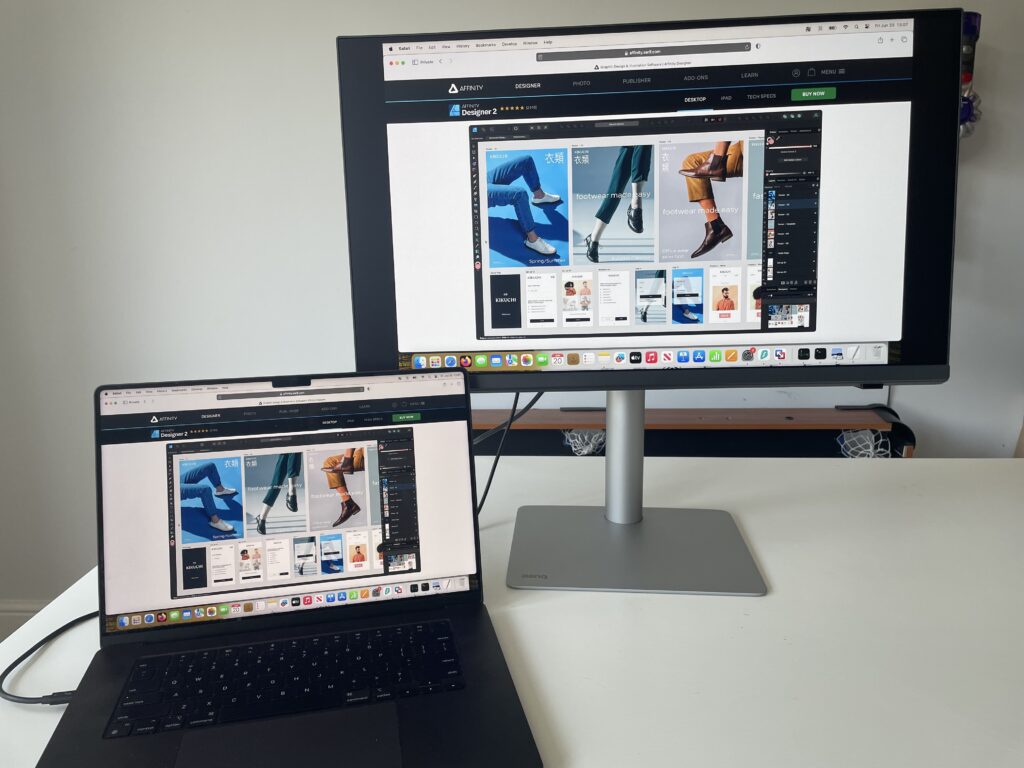
The 27-inch BenQ PD2730S offers up to 400 nits of brightness, which is one area that it falls short of the 600 nits found on Apple’s Studio Display.
400 nits is still more than adequate for most work environments, unless you’re working directly under bright sunlight or harsh overhead lighting.
It does however support both SDR and HDR content, allowing for more vivid contrast and color depth.
HDR400 support means the display can handle HDR metadata and gives you a preview of HDR content, but lacks local dimming and doesn’t reach the brightness needed for serious HDR dependent work.
If HDR mastering is a key part of your work, you may want something with HDR1000 or Apple’s Pro Display XDR – but this is going to cost you a lot more.
It features a 60Hz refresh rate, which is standard for professional displays and perfectly suitable for everyday tasks, video editing, and general creative work, though not ideal for competitive gaming.
With a 5ms response time, the PD2730S handles casual and light gaming reasonably well, but those playing fast-paced shooters or action titles may notice some motion blur.
Another thing I liked is how quickly the PD2730S wakes from sleep when your Mac does.
Many third-party monitors can lag during wake-up, or fail to respond altogether with macOS, but the PD2730S reactivates swiftly and reliably.
As with all external displays on macOS, you can choose to either mirror your Mac’s built-in display or extend your desktop for more screen space.
The PD2730S also works seamlessly in clamshell mode, allowing you to use it as your primary display with the MacBook lid closed.
And for those running Windows on a Mac, whether through virtualization or dual-boot setups, it’s easy to assign macOS to your laptop screen and Windows to the external display to enjoy the best of both worlds at the same time as I did below by using a virtual machine to run Visio on my Mac.
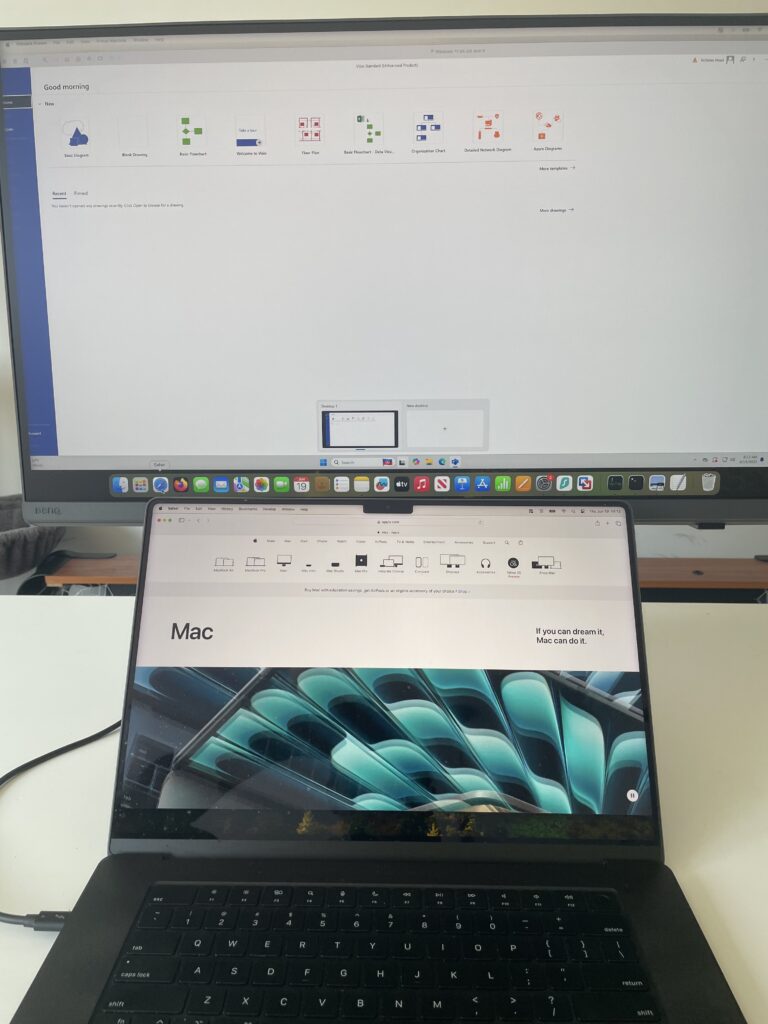
Glare Reduction
Like BenQ’s MA series of monitors, the PD2730S has a Matte finish to prevent glare in brightly lit environments.
This is supposedly enhanced by BenQ’s proprietary Nano Matte technology, which claims to cuts screen reflections to under 3%.
Considering the Apple Studio Display charges several hundred dollars extra for a Matte finish, this is another advantage over Apple’s monitor.
As always, we put the monitor to the test by putting it in direct sunlight and the Matte screen on the PD2730S did a pretty good job of minimizing any glare which you can see on the left-hand side of the screen below.

No external monitor can completely mitigate the effects of direct sunlight well but it’s worth being aware of if you have no choice over where you sit.
Adjustable Stand
Like all BenQ’s monitors, the PD2730S has a flexible stand that allows you to tilt and pivot it however you want.
You can adjust the PD2730S in the following ways:
- Height: Up to 150 mm of vertical adjustment
- Tilt: It supports a tilt from –5° down to +20° up
- Swivel: You get 30° left / 30° right swivel
- Pivot: It offers a full 90° rotation into portrait (vertical) mode
Speakers & Headphones
Like most displays, the BenQ PD2730S comes equipped with a pretty modest audio setup:
- Built‑in stereo speakers: Two 3 W speakers
- Headphone jack: A 3.5 mm output for external audio devices .
No monitor can compare with the Apple Studio Displays spatial audio supporting speakers and our advice is, if this is important to you either go with Apple’s display or buy external speakers.
Wireless Hotkey Puck
Like BenQ’s PD3225U Design Monitor the PD2730S also comes with a control puck (KVM switch) so that you can switch between configuration setups more easily without touching the OSD.
One thing we really liked about this one however is that it’s wireless. The PD3225U was a generation 2 model which had to be connected by an annoying little wire and did clutter the setup a little.
This small, circular dial connects wirelessly to the monitor and sits conveniently on your desk. With just a spin or tap, you can:
- Quickly switch between display modes (e.g. M-Book Mode, sRGB, HDR)
- Adjust brightness, contrast, and volume
- Customize shortcuts for functions you use frequently (like input switching or workspace layouts)
The Puck includes a central dial for navigation and three programmable shortcut keys, giving creatives a quicker and more convenient way to manage workspaces.
All of these functions are configurable via the Display Pilot 2 software.
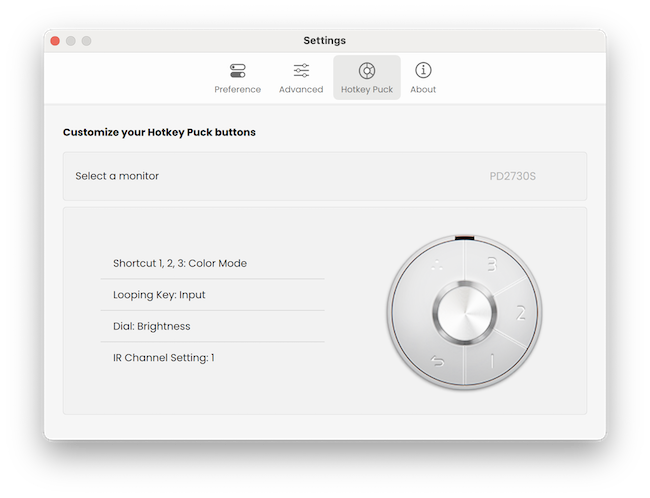
Although most general users won’t need this, it’s especially handy for those working across multiple color profiles, or who need to adjust display settings quickly without fiddling with the OSD.
Who’s It Aimed At?
The BenQ PD2730S is aimed squarely at creative professionals who need high resolution, accurate color, and strong macOS integration in a clean, minimalist display.
It’s also aimed at those looking for an alternative to the Apple Studio Display although considering it costs almost the same as Apple’s display, it’s not really priced competitively enough.
I’d say the key audiences for the PD2730S are:
- Graphic designers, video editors, and photographers: Thanks to its 5K resolution, 99% DCI-P3 color coverage, factory calibration, and HDR support, it’s ideal for color work. If you’re a Final Cut Pro user editing 4K footage, the 5K resolution lets you see the video in full res while still having room for timelines and panels.
- MacBook Pro users: With native Thunderbolt 4 support, 90W charging, and M-book mode, it feels like an external Retina display made specifically for macOS.
- Content creators and multitaskers: The high pixel density (218 PPI) and screen real estate (scaled to 2560×1440) make it excellent for working in multiple windows or across different applications.
- Developers and professionals: Clear text rendering and workspace management tools (via Display Pilot 2) also make it suitable for coding, writing, and spreadsheet tasks.
It’s not really aimed at gamers or those that work in ultra-bright environments.
PD2730S vs PD3225U vs MA270U
The PD2730S will inevitably draw comparisons with BenQ’s other two “Mac friendly” models the PD3225U and MA270U both of which we’ve also reviewed.
The biggest difference of course is that the PD2730S is 5K which in my mind, gives it the ultimate advantage over the other two and if your budget stretches, is definitely worth it for this alone.
A full comparison can be seen below.
BenQ PD3225U vs MA270U vs PD2730S Comparison Table
| Feature | PD2730S | MA270U | PD3225U |
|---|---|---|---|
| Screen Size | 27″ | 27″ | 32″ |
| Resolution | 5120×2880 (5K) | 3840×2160 (4K UHD) | 3840×2160 (4K UHD) |
| Pixel Density (PPI) | 218 PPI | 163 PPI | 140 PPI |
| Color Coverage | 99% DCI-P3 | 95% DCI-P3 | 95% DCI-P3 |
| HDR | DisplayHDR 400 | DisplayHDR 400 | DisplayHDR 400 |
| Brightness (typ/peak) | 400 nits | 400 nits / 550 nits peak | 400 nits |
| Thunderbolt 4 | Yes (2 ports: 90W in, 15W out) | No but supports connecting to Thunderbolt 4 ports via USB-C (1 port: 90W in) | Yes (1 port: 85W in) |
| USB-C | Yes (10 Gbps, 90W PD) | Yes (90W PD) | Yes (85W PD) |
| Daisy-Chaining Support | Yes (via TB4 downstream) | No | No |
| M-book Mode | Yes | Yes | Yes |
| Display Pilot 2 | Yes | Yes | Yes |
| Siri Integration | ❌ | ✅ | ❌ |
| KVM Switch | ❌ | ✅ (Auto-switching) | ✅ (Manual) |
| Speakers | 2× 3W | 2× 5W | 2× 2.5W |
| Glare Reduction | Nano Matte coating | Nano Matte coating | Anti-glare coating |
| Height Adjustment | 150mm | 110mm | 110mm |
| Pivot (Portrait) | Yes | Yes | Yes |
| MacBook Charging | 90W via Thunderbolt 4 | 90W via USB-C | 85W via Thunderbolt 4 |
| Best For | Retina-level macOS scaling & clarity | Mac-centric creatives with smart features | Large-screen pro color work |
PD2730S vs Apple Studio Display
Of course, the other major monitor that the PD2730S is compared to is the Apple Studio Display.
Indeed, unlike many of BenQ’s previous efforts, the PD2730S is a genuine alternative to it since its 5K compared to all of its previous 4K models.
I’ve looked in depth here at the BenQ PD2730S vs Apple Studio Display but the key differences can be summarized as:
- Brightness:
- Apple Studio Display: Brighter at 600 nits → better for very bright rooms.
- BenQ PD2730S: 400 nits → fine for most, but less punchy in sunlit spaces.
- Contrast:
- BenQ PD2730S has almost twice the contrast ratio → deeper blacks, better shadow detail for design/photo work.
- Ports & flexibility:
- PD2730S: More versatile port selection, including bottom-facing ports for easier access.
- Has Thunderbolt 4, while Studio Display has Thunderbolt 3.
- Supports daisy-chaining, which Studio Display does not.
- HDR:
- PD2730S supports HDR400 (basic HDR). Studio Display doesn’t officially support HDR.
- Ergonomics:
- PD2730S: Fully VESA compatible, with height, pivot & tilt adjustability built-in.
- Studio Display: Tilt only, full adjustable stand is $400 extra.
- Premium extras:
- Studio Display: Built-in 12MP webcam, spatial audio, better mic → superior for video calls.
- PD2730S: No webcam, basic speakers.
- Build quality:
- Studio Display: Premium aluminum chassis, best-in-class design.
- PD2730S: Good build but not as premium.
- Controls:
- PD2730S: Handy wireless hotkey puck for on-screen settings + Display Pilot 2 Mac software.
- Studio Display: Controls integrated in macOS, no puck needed.
- Both displays target creative professionals but have different priorities: If you care about color accuracy, both are factory calibrated, but the BenQ’s higher contrast is often better for detail-heavy work like CAD, photo, or 3D design.
- The price difference is significant once you add Apple’s tilt & height adjustable stand.
For more, check out my look at my more detailed look at the BenQ PD2730S vs Apple Studio Display and for other options, the best Studio Display alternatives.
PD2730S Pricing & Availability
The PD2730S is available via B&H, Amazon and of course the BenQ website with a retail price of $1,399.
The best deals are usually to be found on Amazon although promotions usually come and go very quickly.
This is only $200 cheaper than the standard version of Apple’s Studio Display which starts at $1,599 but it does include an adjustable stand (unlike the Studio Display), offers far greater connectivity options and a very similar spec.
However, I do feel BenQ could have priced it a little more competitively. I think there’s a danger that for an extra $200, many users will opt to go with the Apple Studio Display, especially considering refurbished models are often similarly priced to the PD2730S.
It is also considerably more expensive than options like the Asus ProArt Display (around $849 although it lacks Thunderbolt) and refurbished models of the even cheaper SamsungViewFinity S9 (often less than $1000 depending on promotions).
For what you get though, it’s still an amazing monitor and easily one of the best 5K monitors for Macs on the market.


